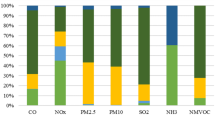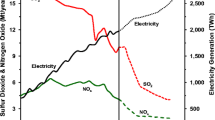Abstract
Reductions in air pollutant emission and ambient concentrations of air pollutants, which would occur in Lima when natural gas (NG) is substituted for existing fuels, were estimated. The analysis suggests that current emission inventories under-predict ambient concentrations. Despite the uncertainty in emissions, the analysis also suggests that significant changes in air pollutant concentrations could be achieved with widespread replacement of diesel and gasoline fuels with NG.











Similar content being viewed by others
References
Cohen AJ, Anderson HR, Ostro B, Pandley KD, Krzyzanowski M, Kunzli N, Gutschmidt K, Pope CA III, Romieu I, Samet JM, Smith KR (2006) Urban air pollution. Comparative quantification of health risks, Chap 17, vol 2. World Health Organization, 2006. Available at: http://www.who.int/publications/cra/chapters/volume2/1353-1434.pdf
CORINAIR/EMEP (2006) Emissions inventory guidebook. European environment agency. 21 December 2006, 11 June 2007 http://reports.eea.europa.eu/EMEPCORINAIR4/en/page002.html
DIGESA (2007) Home Page Direccion General de Salud Ambiental. http://www.digesa.minsa.gob.pe/. Accessed 11 June 2007
Fraser MP, Buzcu B, Yue ZW, McGaughey GR, Desai NR, Allen DT, Seila RL, Lonneman WA, Harley RA (2003) Separation of fine particulate matter emitted from gasoline and diesel vehicles using chemical mass balancing techniques. Environ Sci Technol 37:3904–3909
Lents J, Davis N, Nikkila N, Osses M (2004) Lima vehicle activity study. International sustainable systems research. http://www.gssr.net/ive/
Russell A, Dennis R (2000) NARSTO critical review of photochemical models and modeling. Atmospheric Environ 34(12–14):2283–2324
Schauer JJ, Kleeman MJ, Cass GR, Simoneit BRT (2001) Measurement of emissions from air pollution sources. 3. C1–C29 organic compounds from fireplace combustion of wood. Environ Sci Technol 35:1716–1728
Schauer JJ, Kleeman MJ, Cass GR, Simoneit BRT (2002) Measurement of emissions from air pollution sources. 5. C1–C32 organic compounds from gasoline-powered motor vehicles. Environ Sci Technol 36:1169–1180
Silva-Contrina J, Montoya-Cabrera Z (2004) Análisis de la relación entre el comportamiento estacional de los contaminantes sólidos sedimentables con las condiciones meteorológicas redominantes en la zona metropolitana de lima-callao durante el año 2004. SENAMHI report
Simon H, Wittig AE, Allen DT (2008) Fine particulate matter emissions inventories: comparisons of emission estimates with observations from recent field programs. J Air Waste Manage Assoc 58:320–343
Thompson T et al (2007) Estimating air quality benefits of the use of natural gas in industrial and transportation applications in Lima, Peru. Center for Energy and Environmental Resources (CEER), 15 December 2006. University of Texas Austin. 11 June 2007 http://www.utexas.edu/research/ceer/Documents/PDFs/Lima%20Peru%20Final%20Report%20Jan%202007.pdf
US EPA (1991) SCRAM mixing height data: Oakland, CA. Technology transfer network. http://www.epa.gov/scram001/mixingheightdata.htm. Accessed 28 Dec 2006
US EPA (1999) North American emissions inventories—Mexico. Technology transfer network. http://www.epa.gov/ttn/chief/net/mexico.html. Accessed 22 Jan 2007
US EPA (2005) NONROAD model. Modeling and inventories. http://www.epa.gov/otaq/nonrdmdl.htm. Accessed 11 June 2007
US EPA (2007) National emissions inventories for the US. Technology transfer network. http://www.epa.gov/ttn/chief/eiinformation.html. Accessed 22 Jan 2007
Zhu Y, Hinds WC, Kim S, Shen S, Sioutas C (2002) Study of ultrafine particles near a major highway with heavy-duty diesel traffic. Atmospheric Environ 36:4323–4335
Author information
Authors and Affiliations
Corresponding author
Appendix
Appendix
Identifying sources of PM emissions in Lima
In order to identify emission sources that may be under-predicted in current emission inventories for Lima, samples of PM, collected at sites in Lima on filters, were analyzed for molecular markers of emission sources. Five filter samples were examined, one from each the five monitoring stations in Lima. Each filter contains material that was collected over a 24 h period at a sampling rate of ~1000 m3/h. A summary of the five stations and values for each station is presented in Table 7.
The samples were analyzed to determine the concentrations of a group of n-alkanes, and other tracers, that are known to be markers for vehicle exhaust. For this work, the analysis will focus on the concentration of four n-alkanes: C27H56, C28H58, C29H60, and C30H62. The ratio of the concentration of these n-alkanes to the total concentration of PM in vehicle exhaust has been measured in Houston, using methods identical to those described in this work, by Fraser et al. (2003). The ratios of the concentrations of the molecular markers to the total PM2.5 concentration, and to the PM2.5 elemental carbon (EC) concentration are listed in Table 8.
Concentrations of the molecular markers in the five Lima samples are given in Table 9. Concentrations of total PM2.5 and PM2.5 EC in the Lima samples were then estimated using the ratios listed in Table 7. This yielded four estimates of the concentrations of PM2.5 and PM2.5 EC, at each monitoring site, based on the four molecular markers. The average estimates for each monitoring site, and standard deviations of the estimates, are reported in Table 10.
This procedure was repeated, using ratios of molecular marker concentrations to total PM2.5 and PM2.5 EC concentrations reported by Schauer et al. (2002). Schauer et al. (2002) reported these concentration ratios for both catalyst equipped and non-catalyst equipped gasoline-powered light-duty motor vehicles. The results are shown in Table 11.
The estimates of PM concentrations due to gasoline and diesel exhaust reported in Table 11 represent estimates based on molecular marker emission ratios derived from three different vehicle fleets. The first set of Schauer estimates come from a fleet of vehicles without catalyst enhanced emission controls. The second set of Schauer estimates come from a fleet of vehicles that have catalyst emission controls. The Fraser data represents a mixed fleet with an unknown percentage of catalyst-equipped vehicles. The fleet in Lima is a combination of catalyst and non-catalyst controlled vehicles. Lima, when compared to Houston, is likely to have a larger percentage of the vehicle fleet without catalyst operating controls due to the availability of leaded gasoline in Lima, which can poison catalytic converters.
The last two columns in Table 11 report the PM and PM2.5 ambient concentrations that result from on-road mobile emissions. On-road emissions values were reported by DIGESA and then adjusted to account for missing emissions. This was done by changing the input emissions values until the output concentrations best matched values being measured by the monitors in Lima. The average ratio of reported on-road emissions to the estimated missing emissions was 30. Therefore the PM and PM2.5 emissions values were multiplied by a factor of 30 before they were input into the air quality model. The resulting output concentrations are reported here.
The results from this analysis show that with the exception of the Northern region of Lima, the PM observed in Lima is largely due to diesel and gasoline engine exhaust. This supports the conclusion that the source of the “missing” PM emissions in Lima is most likely on-road and non-road gasoline and diesel engines, and therefore, that use of NG as a transportation fuel would have a large positive effect on air quality.
Finally, the contributions of cellulose combustion (paper and vegetation burning) to ambient PM concentrations were estimated, using a procedure similar to that described above. In this case, levoglucosan was used as a molecular marker for cellulose combustion and the ratio of total PM emissions to levoglucosan concentrations was based on a study of wood burning by Schauer et al. (2001). The resulting PM concentrations, attributed to cellulose burning were on the order of ng/m3. This analysis led to the conclusion that cellulose combustion, and therefore trash and wood burning is not a significant contribution to PM emissions in Lima.
Rights and permissions
About this article
Cite this article
Thompson, T., Kimura, Y., Durrenberger, C. et al. Estimates of the air quality benefits of using natural gas in industrial and transportation applications in Lima, Peru. Clean Techn Environ Policy 11, 409–423 (2009). https://doi.org/10.1007/s10098-009-0199-2
Received:
Accepted:
Published:
Issue Date:
DOI: https://doi.org/10.1007/s10098-009-0199-2




